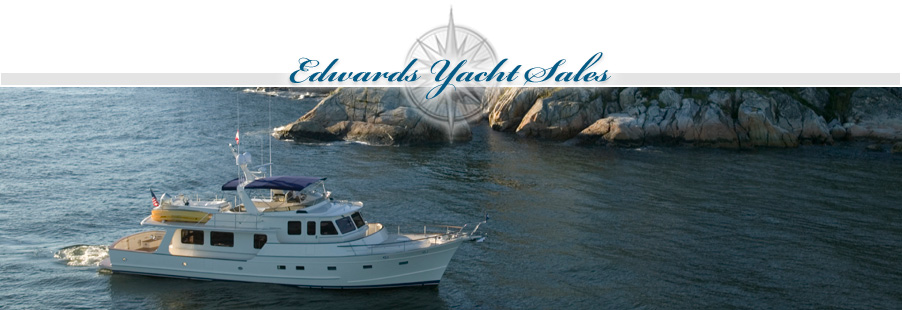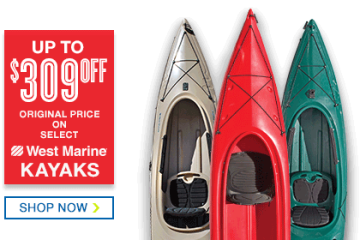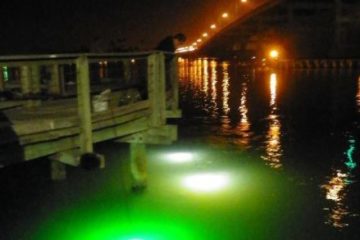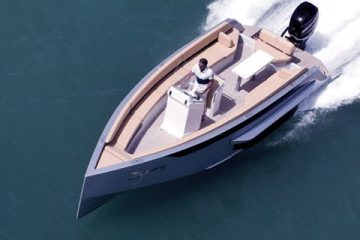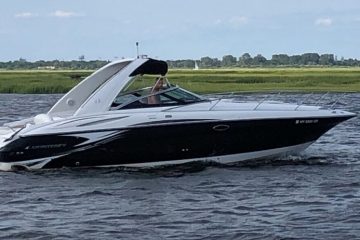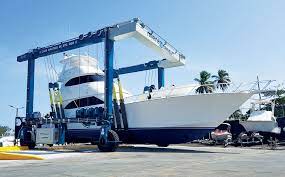
Jupiter Marine’s 38 Caribee
Description
By Jim Hendricks
The grace with which Jupiter Marine****’s 38 Caribee edition glided across the waves belied the sea state off Islamorada, Florida, the day I fish-trialed this center-console with Capt. Billy Harbaugh and Bill Gilbert, manager of Caribee Boat Sales. Powered by triple F300 Yamaha outboards, the boat bounded headlong at almost 40 mph into steep 4-footers on this April day. The 38-foot, 2-inch hull — reinforced by a fiberglass unigrid stringer system and high-density matrix core transom — knifed smoothly through the whitecaps with nary a thump.
“Big boats do make a difference, especially on days like this,” I said to Harbaugh, who nodded in agreement as he throttled back near our first fishing spot in 180 feet of water, where he planned to target mutton snapper.
The proven deep-V-hull design by Donald Blount and Associates with a rather steep 24 degrees of deadrise at the transom played heavily in favor of a comfortable ride. Yet, it’s not the running surface, but rather the interior layout, that’s new here. Islamorada-based Caribee Boat Sales worked closely with Jupiter Marine designers in Palmetto, Florida, to integrate new hard-core-angling features, as well as a few creature comforts.
Built for Bait
Expanded livewell capacity distinguishes the Caribee edition from other iterations of this model. “We definitely like to carry lots of live bait,” says Gilbert, representing the views of not only the boat dealership, but also most of the South Florida saltwater-angling community.
Jupiter integrated three big livewells into the design: twin 38-gallon tanks built into the transom bulkhead and a 40-gallon well within an innovative, multipurpose helm module. The module accommodates helm seating, aft-facing seats, and tackle storage, including cabinets along both sides, with room to slide 10 plastic tackle boxes in each.
The transom livewells each have clear-acrylic latching lids and are separated by an alcove into which an angler can wedge while fighting a fish astern.
The design dispenses with a transom door; however, a beefy side door on the port side of the aft cockpit allows for easy boarding at the dock and easy boating of a big fish offshore.
The central livewell features an aquarium-style window to keep an eye on your precious pilchards without inconveniencing guests enjoying the comfortable seats atop the well. All three wells are fed from a pump box that holds four Rule 2000 pumps; the plumbing setup allows you to switch pumps in case of a failure.
During our trip, we used only the transom wells. Earlier in the day, Harbaugh — who also runs a business selling live bait to boating anglers from November through April — loaded 18 goggle-eyes in one tank and about 25 pinfish in the other, giving us plenty of ammo for our mutton mission. Not a single bait died in the wells, a strong testament to the life-sustaining design of the 38 Caribee’s tanks.
Beamy and Stable
As I was to learn, Harbaugh has developed an effective power-drifting approach for targeting mutton snapper on what he refers to as “live-bottom areas.”
Harbaugh’s technique involves drifting a bridled live bait using a 50-foot leader of 30-pound-test -fluorocarbon behind a swivel connected to the 20-pound-test braid main line. He uses a short piece of copper wire to connect a 12-ounce bank sinker to the swivel to keep the bait near the bottom. “It’s important to have a very long leader,” he explains. “Otherwise you’ll spook the mutton.”
Fishing a single rod amidships on the starboard side in one of 18 stainless-steel gunwale rod holders on this boat, Harbaugh put the Jupiter 38 Caribee on a drift, shifting the engines in and out of gear to keep us abeam of the 15- to 20-knot winds. I was surprised by the stability in the trough. The -10-foot-7-inch beam tamed the roll.
Within five minutes, the rod bowed over hard, and Gilbert picked it up and reeled down to embed the circle hook. As he fought the fish to the boat, we saw it was a black grouper weighing about 16 pounds. But since grouper were out of season during our trip, we took a few photos and then quickly released it.
Mutton Move
Rather than risk catching any more out-of-season grouper, we decided to move to one of Harbaugh’s other spots — this one in 140 feet of water. That gave me the chance to pilot the boat from the comfort of the twin helm seats, each featuring fold-down armrests and flip-up bolsters with heavy-duty, polished stainless-steel hardware. There are also individual footrests.
Our boat was equipped with the Yamaha Helm Master system, which includes digital throttle and shift, joystick low-speed steering control, Command Link Plus engine monitors, and power steering, which allowed me to easily control the three big V-6 outboards.
The clear polycarbonate windshield that extended from the hardtop to the console and wrapped around the helm kept us protected from wind blast. Harbaugh used the two flush-mounted Garmin 8215 multifunction displays with networked sonar and GPS/chart plotter to line up on a drift that would take us across the productive area.
As we drifted and waited for a bite, I explored forward and found that the center console of the Caribee edition extends forward with a hatch that lifts to reveal a mini coffin box. Yet when you close this hatch, the extension becomes an inviting lounger.
The Caribee edition features a flush foredeck with a pair of pods on either side. Not only do these offer storage inside, with the addition of snap-on cushions and slide-in -backrests, you get two more loungers.
Two additional concealed storage compartments are integrated into the forward inwales with racks for hanging dock lines. A pair of in-sole lockers flanks the center console with racks for storing four rods in each.
Inside the console (accessed by a companionway on the portside) are amenities such as a permanent toilet and sink with a freshwater faucet. I also discovered access to the immaculate helm rigging and batteries. There’s also a shelf and bungee-cord system on the forward interior wall for -conveniently storing fishing kites.
Fish On!
My investigation was interrupted by commotion topside. As I hustled out, Harbaugh pointed at the bucking rod and yelled, “It’s your turn!” As I pulled the rod out of the holder, I was immediately pinned to the rail. “Now that’s a mutton,” said Harbaugh, as the silvery flash of the snapper first appeared at deep color. At about 7 pounds, it wasn’t huge, but we got our target species, and we quickly iced the tasty fish in one of the twin 104-gallon fish lockers flanking the aft cockpit sole. Yet, Harbaugh wasn’t satisfied. “I’ve got another spot in 150 feet where we might get a bigger one,” he advised.
The short move allowed me to snoop around some more. I found a Lewmar ProFish windlass concealed inside the bow hatch, with the anchor line feeding through a roller integrated into the bow stem below the forepeak. A fold-down step on the forward -bulkhead eases access to the bow deck. A pair of pull-up stainless-steel cleats keeps the bow snag free.
A pair of big-boat-style hawse pipes in the stern quarters and again amidships lead to heavy-duty cleats underneath. I found the gunwales hit my 6-foot frame at waist level in the bow, hip level amidships, and thigh level aft. Thickly padded coaming bolsters encircle the interior.
The hardtop on the test boat was equipped with a pair of outriggers, a Garmin open-array radar, a rack for storing six rods, and a second station, accessible via a hatch and integral ladder on the portside of the top. The second station seats two and has a hardtop of its own.
My upward gaze suddenly diverted downward to the rod as it again bent over, and this time Gilbert grabbed it. Harbaugh and I peered into the water and finally glimpsed a flash — a sure sign of a mutton. This one was twice as big as mine — a solid 14-pounder. “Mission accomplished,” said the captain, as the fish went on ice.
With that, we used the standard raw-water and freshwater washdowns to clean up the deck and prepare for the run back. As we throttled up, the triple 300s brought the 38-footer to plane in 5.5 seconds and to 30 mph in 7.1 seconds. In the protected waters of Florida Bay on the way back to Caribee Boat Sales, we achieved a top speed of 58 mph, with the best fuel economy occurring at 3,500 rpm and 29 mph, where the trip F300s collectively burned 28.4 gph, achieving 1.02 mpg. That translates to a range of 500 miles with the 485-gallon fuel tank.
The Jupiter 38 Caribee edition is a boat you can fish in just about any sea condition with comfort and safety. And with 106 gallons of livewell capacity, you’ll still have the bait to catch fish when other boats are heading in to reload. With so much ammo, this Jupiter truly represents a 38 special.
PERFORMANCE
Power: Three Yamaha F300 outboards
Load: 400 gallons of fuel, 50 gallons of fresh water, three adults, fishing gear, full livewells
Top Speed: 58 mph
Time to 30 MPH: 7.1 sec.
Best MPG: 1.02 @ 29.0 mph (3,500 rpm)
HULL
LOA: 38 ft. 2 in.
Beam: 10 ft. 7 in.
Deadrise: 24 deg.
Weight: 8,970 lb. (dry w/o engines)
Draft: 24 in.
Fuel: 485 gal.
Max Power: 1,050 hp
MSRP as Tested: $329,000*
*(base price with triple Yamaha F300 outboards)
Jupiter Marine
Palmetto, Florida
941-729-5000
Map
Featured Listings
More from BoatNation approved Dealers
You may also like...
Popular Boat Brands
- Albin
- Azimut
- Bayliner
- Beneteau
- Bertram
- Boston Whaler
- C&C
- Cape Dory
- Carver
- Catalina
- Cheoy Lee
- Chris Craft
- Contender
- Formula
- Grady-White
- Grand Banks
- Gulfstar
- Hatteras
- Hinckley
- Hunter
- J/Boats
- Jeanneau
- Lagoon
- Luhrs
- Mainship
- Morgan
- Nordhavn
- Ocean Alexander
- Pearson
- Pursuit
- Regal
- Sabre
- Sea Ray
- Silverton
- Sunseeker
- Tartan
- Tiara
- Viking
- Wellcraft
BoatNation.com is a member of the following associations:
- International Marine Association ®
- Marine Industries Association of South FL
- International Yacht Brokers Association





